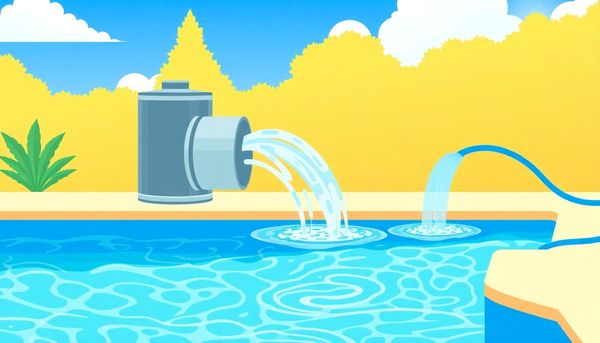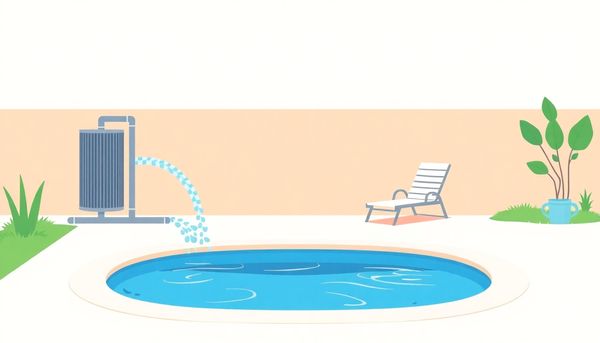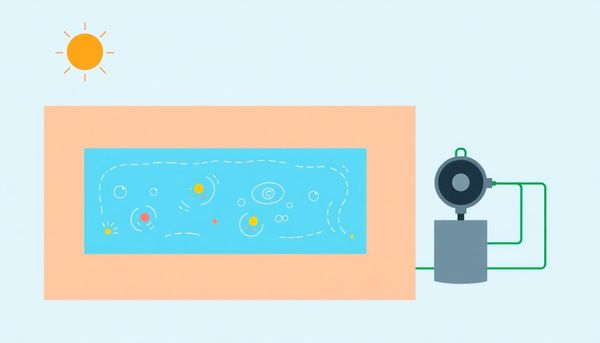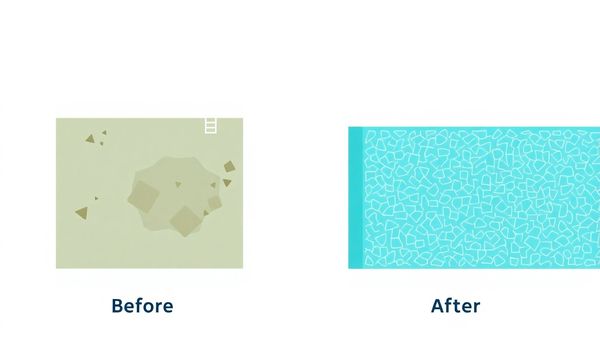Master Pool Backwashing: Essential Tips for Crystal Clear Water
April 02th, 2024
April 02th, 2024
In the realm of pool maintenance, the art of backwashing stands as a crucial ritual, akin to giving your pool filter a breath of fresh air. On a sunny afternoon, as children splash joyfully in the clear blue water, the unseen hero ensuring their safety and delight is the pool filter. It works tirelessly, trapping impurities and debris, yet even the most diligent filter requires periodic rejuvenation. This is where backwashing comes into play—a process as essential as changing the oil in your car.
Different filters call for varied methods; sand, DE, and cartridge filters each have their own quirks and requirements. Mastering the technique involves understanding your specific filter type, recognizing the signs of a clogged system, and knowing when to spring into action. During a recent summer, I faced the challenge of a cloudy pool despite regular maintenance. It was only after learning the nuances of my sand filter's backwashing process that clarity was restored, both in the water and my understanding.
Understanding how to backwash effectively not only extends the life of your filter but also keeps the pool inviting and safe. This guide endeavors to equip you with the insights needed for this task, ensuring the time and effort you invest in maintaining your pool rewards you with crystal clear water and peace of mind.

The heartbeat of your pool’s cleanliness lies within its filter. Mastering the art of backwashing is crucial for maintaining a pristine swimming environment without the hassle of disassembling your filter. This chore, often perceived as daunting, is quite straightforward when approached the right way.
Start by ensuring your pool pump is switched off. You'll want to avoid unnecessary repair costs from a damaged valve gasket. Next, connect a backwash hose to the filter’s waste port. This handy hose ensures that dislodged debris exits smoothly, without leaving a mess behind. Turn the multiport valve to the ‘Backwash’ position, and start the pump. Watch the sight glass or the hose end for the water’s clarity; when it runs clear, the dirt has bid farewell.
For D.E. filters, introduce fresh diatomaceous earth into the skimmer to coat the grids inside, enhancing their filtration prowess. Sand filters, on the other hand, need no such addition—just a reverse flow to shake off the grime.
Once done, switch off the pump and return the valve to the ‘Filter’ position. Restart the system, and bask in the knowledge that your pool water is now ready to sparkle. Regular maintenance like this not only extends your filter’s lifespan but also keeps those fun summer pool days worry-free.
Standing beside your pool, gear in hand, the task of backwashing becomes less of a chore and more of a ritual in pool maintenance. As you embark on this process, think of it as helping your pool breathe easier. First, you need to shut off the pump; a crucial step that ensures your multiport valve's delicate internal components stay intact. Once the pump is off, move the multiport valve handle to the “Backwash” setting. This action is akin to flipping the script, allowing water to flow in reverse and carry away trapped debris.
Next, roll out that trustworthy backwash hose and connect it to the filter’s waste port. This hose is more than just a piece of equipment; it's your ally in guiding water safely away from your pool area. With everything in place, turn the pump back on and watch as water starts its reverse journey, visibly cloudy at first but gradually clearing. This transformation is your cue to stop the backwash, usually after two to three minutes, or until the sight glass—if your filter has one—shows clear water.
Before you celebrate a job well done, don’t forget the rinse cycle. Set the valve to “Rinse” and run the pump for about a minute. This step reseats the filter media, preventing any loose dirt from returning to your pool. Finally, return the valve to its “Filter” position, turn the pump back on, and bask in the satisfaction of a job well done. As you pack away your tools, remember that mastering backwashing not only extends your filter’s life but also keeps your pool in pristine condition, one backwash at a time.
Pooling memories of long summer days spent lounging by the azure waters, it's easy to forget the silent workhorse behind that inviting sparkle: the pool filter. While backwashing is a straightforward process, one often overlooked aspect is ensuring the longevity of your equipment. Just like any well-cared-for machine, your filter, be it sand or D.E., has specific needs to keep it running smoothly.
First things first, always turn off your pump before adjusting the multiport valve. Failing to do this can cause severe damage, like a broken diverter gasket, which not only disrupts your day but leads to costly repairs. Speaking from personal experience, the price of one overlooked step can quickly escalate into an unexpected budget buster.
Consider the condition of your backwash hose, too. A well-maintained hose prevents unnecessary water loss and environmental damage. It should be free of kinks and punctures, ensuring optimal water flow and proper disposal.
Don't ignore the pressure gauge, your best friend in pool maintenance. Regularly check it to anticipate backwashing needs, rather than reacting when the pool water is less than pristine. By keeping the gauge in your sights, you preserve the integrity of your filter, extending its life and saving on replacement costs.
Remember, each component in your pool system plays a vital role. Protecting your equipment not only enhances performance but also maintains that crystalline allure of your backyard oasis.
Dealing with backwash water is one of those tasks that doesn't seem daunting until you realize the impact it might have if not done correctly. Imagine the aftermath of just releasing chemically treated water into your garden or the nearby creek. It's vital to find a responsible and environmentally friendly way to dispose of this water to avoid harm to local ecosystems and potential fines from your local authorities.
To navigate this process smoothly, first reach out to your local water authority. Regulations vary, but they can provide precise guidelines on where and how you can dispose of pool water. In some areas, storm drains may be an option, though often with the need for a permit. Furthermore, they might instruct you to neutralize the water by reducing chemical concentrations before disposal.
Another potential solution is connecting the backwash hose to your home’s plumbing cleanouts, assuming your municipality permits it. However, avoid the septic system, as pool water, especially with chlorine, can disrupt the biological processes crucial for its function.
In regions with specific restrictions, constructing a dry well could be a long-term investment, though costly, to safely manage large volumes of water. This step, however, should not be your first choice due to the significant expense and regulatory hurdles. Ultimately, a quick conversation with your local water authority is a small step toward protecting your community and environment.

Mastering the art of pool maintenance often starts with understanding how to backwash effectively. When I first faced the daunting task of backwashing my own pool filter, I was pleasantly surprised to learn it wasn’t as complex as it seemed. It’s all about reversing the water flow through your filtration system, expelling the accumulated debris that clogs the filter and impedes performance.
First and foremost, always remember to shut off the pump before adjusting the multiport valve. This small step prevents potential damage to the valve gasket, saving you from unexpected repairs. One afternoon, I learned this the hard way when a hasty mistake led to a minor flood in my backyard. Since then, I make sure to follow each step meticulously.
Choosing the right backwash hose can also make a world of difference. Opt for one that's easy to handle and store, as this will simplify the process. Once you have your hose connected, position it so that the expelled water doesn’t cause harm to your garden or local waterways. My neighbor, who’s quite the eco-warrior, taught me about the importance of consulting city regulations regarding water disposal. It turns out maintaining our pools responsibly helps preserve the environment.
Lastly, don't overlook the pressure gauge. It’s a silent but vital communicator, letting you know when your filter needs attention. Keeping an eye on it ensures you catch potential issues early, maintaining not just the clarity of your pool but its overall health. With these techniques in hand, backwashing becomes an integral, almost therapeutic part of pool upkeep.
Efficiently managing the backwashing process of a pool filter extends beyond mere routine; it’s about ensuring the longevity of your pool’s heart, the filter. To get started, you need to understand your filter’s specific needs, whether it’s a sand filter or a D.E. (diatomaceous earth) filter. Each type requires slightly different handling, but the core principle remains the same: reversing water flow to dislodge trapped debris.
First, familiarize yourself with your filter’s pressure gauge. When it reads 10 psi above the normal level, it’s a clear signal that backwashing is necessary. This isn’t just about keeping your filter clean; a bit of dirt actually aids filtration before the system becomes fully clogged. Once the decision to backwash is made, ensure all equipment is ready, particularly a backwash hose that is durable and easy to store.
When performing the backwash, always turn off the pump before adjusting the multiport valve. This simple step can prevent costly damage to the internal workings of your filter. Remember, the waste water doesn’t just disappear. Responsible disposal is crucial, as incorrect handling can lead to environmental harm and potential fines. Check local regulations to determine if special permits are needed for disposing of chemically treated water, ensuring both legal compliance and eco-consciousness.
Employing these effective backwashing methods not only keeps your pool sparkling but also preserves the efficiency and lifespan of your filter system. Your pool—and the environment around it—will thank you for it.
Handling backwash water with care ensures not only a pristine pool but also a healthy environment. Once you've reversed the flow of your pool’s filter, the next crucial step is finding a responsible way to dispose of the expelled water. Backwash water, though seemingly harmless, is infused with chemicals like chlorine and other treatment agents that can wreak havoc on local ecosystems if not properly managed.
One potential option is checking if your local regulations allow you to empty pool water into storm drains. Some municipalities permit this, but it's essential to verify whether you need a permit first. Regulations can vary, and failing to comply might lead to fines. Moreover, if you're allowed to use the storm drains, there may be stipulations about reducing chemical concentrations in the water.
Alternatively, consult your water authority to learn whether you can channel the backwash into your home’s plumbing cleanouts. This method can be practical, yet again, it requires confirmation of compliance and possibly pre-treatment of the water. Importantly, avoid directing the water into a septic system. The chemicals can disrupt essential biological processes, leading to costly complications.
If legal and environmental considerations prove challenging, constructing a dry well could be a solution. However, this option demands professional installation and might be a financial commitment. Exploring these avenues with your local water authority ensures that you’re not only protecting your pool but also contributing positively to environmental conservation.
Ensuring your pool filter operates at its best is somewhat like maintaining a fine-tuned instrument; both require care and attention to detail. Your pool's crystal-clear water hinges on how effectively your filter does its job, and backwashing plays a pivotal role in this process. By routinely backwashing, you’re essentially giving your filter a fresh start without the hassle of disassembling it. With each backwash, you force trapped dirt and oils out of the filter medium, renewing its efficiency.
A few summers ago, I remember my friend Sarah fretting over her murky pool. It turned out her sand filter was overdue for a backwash. Once she followed the steps, the transformation was significant. The water clarity improved almost instantly, and the pressure on her gauge dropped, reflecting a healthier system. She realized that scheduling regular backwashing was not just about aesthetics but also about prolonging the life of her filter.
Regular monitoring of your filter's pressure gauge is key. When it spikes 10 psi above normal, it's a clear sign your filter needs attention. But be careful not to overdo it; some debris in the filter can actually aid in capturing finer particles. Balancing this ensures your filter remains a diligent guardian of your pool’s water. With thoughtful maintenance, you’ll keep your pool inviting and your filter running smoothly for years to come.

Ensuring the longevity of your pool filter hinges on more than just regular backwashing; it’s about understanding and respecting the intricacies of your system. Many pool owners overlook the importance of gentle handling, especially when it comes to the multiport valve. A careless twist while the filter is running can lead to costly repairs, such as a damaged diverter gasket. This small rubber ring is vital, as it directs water to the correct ports, preventing leaks and maintaining efficiency.
Think of your filter as the unsung hero of your pool’s ecosystem. It tirelessly captures impurities, but it can only do so efficiently when treated with care. Consider maintaining a routine check on your pressure gauge. When it reads 10 psi above normal, your filter is crying out for a backwash. Ignoring this not only compromises water clarity but also stresses the filter, decreasing its lifespan.
Additionally, be mindful of the environment when disposing of backwash water. Chemically treated water can disrupt local ecosystems, so always consult your local water authority to dispose of it responsibly. This simple step not only protects nature but also keeps you within legal boundaries.
In short, a little forethought and care can keep your filter running smoothly, saving you from unexpected expenses and ensuring that your pool remains a haven of relaxation.
Keeping your pool filter in tip-top shape involves more than just flipping a switch; it requires a keen understanding of backwashing guidelines. The first step is knowing when it’s time. Observe your pressure gauge routinely. When it reads 10 psi above the standard operating level, it's a signal to backwash. Though it might be tempting to jump the gun, patience is key. Allowing a slight buildup of debris can actually enhance your filter’s efficiency by trapping finer particles, much like a net.
Once you’re ready to backwash, make sure to turn off the pump before adjusting the multiport valve. Turning the valve while the system is running can damage the internal gasket, leading to frustrating leaks. Having witnessed this mishap firsthand, I can assure you it’s a lesson best learned from others.
Don’t forget about the environmental aspect. Plan ahead for where you’ll direct the backwash water, as haphazard disposal can harm local ecosystems and even lead to fines. Check with municipal guidelines to determine the safest and most legal disposal method, whether it be a sewer system or a specially designated area.
With these considerations in mind, you can backwash with confidence, ensuring both your pool's clarity and your community's safety. This attention to detail not only prolongs the life of your filter, but also contributes to a more sustainable pool maintenance routine.
In the realm of pool maintenance, backwashing plays a crucial role. But what happens after you’ve reversed the flow and purged the filter of its debris? The resulting backwash water, laden with chemicals and impurities, demands thoughtful disposal. Simply sending it down the nearest storm drain or letting it spill into your yard isn't an option. Not only is this practice frequently against local regulations, but it also poses significant environmental risks, affecting plant life and water sources.
The first step is to consult your local water authority. They can provide guidance on legal disposal methods in your area. Some municipalities permit discharge of treated pool water into storm drains, though this often requires a permit and specific conditions to be met, such as neutralizing chlorine levels beforehand. Another possibility is channeling the water into your home’s plumbing cleanouts, yet again, local rules govern this option, and permission may be required.
Septic systems, however, are a definitive no-go. The chemicals in pool water can disrupt the biological processes essential to the system's operation. If neither of these options is available, consider investing in a dry well, built by professionals, to safely manage the overflow. While this can be a more costly solution, it ensures that the water is absorbed in a manner that doesn’t threaten local ecosystems or violate regulations. By taking these precautions, you protect both your community and the environment, reaffirming your commitment to responsible pool ownership.
Keeping an eye on your pool's filter pressure isn't just a good idea; it's a necessary routine that can extend the life of your filter and ensure sparkling water. Think of the pressure gauge on your filter as a window into the filter’s health. When you set up your pool filter, note the baseline pressure reading. This number is your filter's happy place—where it hums along, doing its job effectively.
As time passes, your filter collects dirt and debris, causing the pressure to climb. A reading that spikes 10 psi above that baseline is a clear cry for a backwash. Ignoring this call could mean reduced filtration efficiency, putting your pool at risk of murkiness and algae growth. However, if you're tempted to backwash before reaching that 10 psi mark, hold off. A slightly dirty filter isn't the enemy; in fact, the accumulated debris can enhance filtration by trapping even finer particles.
Regular pressure checks can transform you from reactive to proactive in pool care. For instance, I recall the time I neglected this simple task. By the time I noticed, my pool had a greenish hue, and it took days to restore its clarity. That little oversight was a lesson in the significance of monitoring pressure. Embrace this small habit, and your pool will thank you with clear, inviting water every time you dive in.
Dealing with the aftermath of backwashing, it's crucial to handle the expelled water responsibly to prevent environmental harm and adhere to local regulations. Backwash water contains chemicals like chlorine, which, if improperly discarded, can pose threats to ecosystems. Imagine emptying this water onto your lawn or into nearby streams—many places legally prohibit such actions due to potential damage to plants and aquatic life.
First, familiarize yourself with local guidelines. Some areas permit the discharge of pool water into storm drains, but this often requires a permit. You might also need to adjust chemical levels in the water before doing so, particularly if you’re dealing with a saltwater pool. Contact your local water authority to understand permissible disposal methods and whether any pre-treatment of the water is necessary.
Alternatively, consider directing backwash water into your home’s plumbing cleanouts, if allowed. This method often requires approval and possibly modifications to your setup. Avoid septic tanks, as the chemical-laden water can disrupt the bacterial balance crucial for waste decomposition.
For those in regions with high rainfall, a dry well might seem tempting. However, this solution is typically costly, requires professional installation, and isn’t always permissible for pool water disposal. Instead, consult with professionals or your local water authority to find a suitable and legal method. By responsibly managing your backwash water, you contribute to environmental preservation and community safety.
Exploring legal disposal options for pool backwash water is crucial to both safeguard the environment and avoid hefty fines. The chemically treated water, once released from your pool, carries potential risks to plant life, groundwater, and aquatic ecosystems. That's why your first step should be to consult your local water authority. They can provide detailed information on the permissible methods and necessary permits for disposal.
In some locales, discharging backwash water into storm drains is allowed, often contingent upon obtaining a permit. This route typically requires an assessment or reduction of chemical levels within the water, ensuring it meets environmental standards. Alternatively, you might be permitted to use your home’s plumbing cleanouts, though this too requires confirmation from local authorities regarding any pretreatment steps or necessary permits.
Directing backwash water into a septic system is virtually never allowed, as the chlorine and other chemicals can disrupt the delicate balance of enzymes crucial for waste breakdown. Similarly, while a dry well might seem a viable option, its construction can be costly and often doesn’t align with municipal regulations due to the risk of groundwater contamination.
Ultimately, your local water authority is your best ally in navigating these disposal options. They can guide you toward sustainable methods, ensuring your pool maintenance routine doesn’t inadvertently harm the environment.
Before you undertake the task of backwashing your pool filter, there's a crucial step you might not have considered: reaching out to your local water authorities. This isn't just a bureaucratic hoop to jump through—it's about understanding the legal and environmental implications of your actions. When I first tackled backwashing my pool, I assumed the water could simply drain into the yard. A quick call to my local authority saved me from a potential fine and taught me about the eco-friendly ways to handle pool water disposal.
Different regions have distinct regulations regarding the disposal of chemically treated water, which can impact both public health and local ecosystems. For instance, some municipalities permit the discharge of pool water into storm drains, while others may require you to obtain a specific permit or reduce the chemical levels before disposing of the water. Moreover, dumping backwash water into a septic system is generally a no-go, as it can disrupt the balance of enzymes crucial for waste decomposition.
Consulting with your local water authority offers clarity on acceptable practices and helps safeguard your community. They can guide you on whether to channel the water into a sewer system or suggest alternatives. It's a small effort that ensures you're not only maintaining a pristine pool but also contributing to a healthier environment.
Backwashing your pool filter is a vital maintenance task, but it’s essential to consider the environmental impact of this process. While it may seem straightforward to simply let the water run out, improper disposal can result in significant harm. For instance, the chemically treated water from your pool, rich in chlorine and other sanitizers, can damage local plant life and contaminate groundwater.
Instead of letting backwash water flood your yard or trickle into nearby waterways, explore environmentally-friendly disposal options. Many municipalities offer guidelines for safely disposing of pool water, which may include directing it to designated storm drains. However, it’s crucial to verify these practices with your local water authority, as some areas require permits and pre-treatment to reduce chemical levels before disposal.
Another option might be connecting the backwash output to your home’s plumbing cleanouts, though this also requires approval from local authorities. They will inform you about necessary permits and treatment steps to ensure minimal harm to the environment. Remember, septic systems are generally off-limits for pool water disposal due to the risk of damaging the biological processes they rely on.
By responsibly managing backwash water, you contribute to protecting your local ecosystem while maintaining a clean and efficient pool. This conscientious approach not only prevents environmental damage but also helps you comply with local regulations, avoiding potential fines.

Amidst the gentle whispers of rippling water, maintaining your pool’s pristine allure can feel like a never-ending quest. Yet, enhancing pool water quality need not be a daunting task. The secret lies in understanding and effectively executing the art of backwashing. This process not only revives your filter’s performance but also ensures that every dip is refreshing and safe.
For me, it began one sunny afternoon, when my pool’s formerly vibrant blue had morphed into a murky shadow of its former glory. A quick check of the pressure gauge revealed the culprit: the filter was clogged with debris. Backwashing came to the rescue. By reversing the water flow through the filter, it flushed out the trapped impurities, restoring the filter’s efficiency. It's like giving your pool a deep, rejuvenating breath.
Different filters may require slight variations in the procedure, but the essence remains the same. With a sand filter, the sand stays put while contaminants are expelled. For D.E. filters, fresh powder is needed after backwashing to reset the system. This keeps the filtration cake intact, ready to capture even the finest particles.
However, don’t overlook where this expelled water ends up. Proper disposal is crucial to protect the environment—and your wallet from potential fines. Always verify local guidelines on chemical-treated water disposal. Once you've mastered this routine, you'll notice not only clearer water but also a healthier pool ecosystem, extending the life of your filter and enhancing every swim.
Backwashing your pool filter doesn't require a magic wand, but it does need some care and attention. Let’s unravel this process step by step, ensuring your filter stays in top shape and your pool remains a sparkling oasis. First, acquaint yourself with your filter type—be it sand or D.E. Each has its specific procedure, so dust off that owner's manual for a quick refresher on your system’s quirks.
Standing by your pool with a backwash hose in hand, ensure the pump is turned off. This prevents mishaps such as gasket damage, which could lead to leaks. Now, set the multiport valve to the “backwash” position. Once everything is in place, power the pump back on, allowing the water to flow in reverse. This process dislodges the dirt and debris that have overstayed their welcome in the filter medium.
Keep a keen eye on the sight glass or discharge hose; when the water runs clear, it’s time to shut off the pump. Switch the valve to “rinse” for 30 seconds, ensuring any residual dirt doesn’t sneak back into the pool. After rinsing, reposition the valve to “filter” and restart the pump.
Remember to properly dispose of the backwashed water. Consult local regulations to avoid inadvertently harming the environment or violating laws. With these steps, your pool filter will thank you, maintaining your pool’s allure and keeping you happily afloat all season long.
Every pool owner knows the satisfaction of seeing crystal-clear water shimmering under the sun. But behind that sparkling scene lies the crucial task of backwashing the pool filter, a process that can temporarily result in a hefty amount of wastewater. The challenge? Ensuring this backwash water doesn’t wreak havoc on the environment or violate local regulations.
First off, consider the chemistry involved. Backwash water is loaded with chemicals like chlorine, which, while essential for pool maintenance, can harm local ecosystems if not disposed of correctly. It’s tempting to let it flow into your garden or down the street, but that could lead to damaged plants or hefty fines, depending on your local laws.
Some municipalities allow pool water disposal into storm drains, but this often requires jumping through a few hoops, like obtaining permits or treating the water to reduce chemical levels. Always consult your local water authority to understand the specific requirements in your area. They may require you to channel the water into your home's sewer system, a task that might sound daunting but is manageable with the right guidance.
Moreover, the septic system is a definite no-go. Pouring chemically treated water into it could disrupt its delicate balance, leading to costly repairs. Instead, consider alternatives like using a dry well, though these require professional installation and can be expensive.
Ultimately, being informed about disposal methods not only protects the environment but also keeps you on the right side of the law. This knowledge ensures your pool remains a source of joy, not a regulatory headache.

This article provided insights into maintaining your pool. Start your pool care journey today!
Want to become a pool maintenance expert? Our free Pool School course covers everything you need to know about pool care. From basic maintenance to advanced troubleshooting, you'll learn how to:
Join over 10,000 pool owners who have already transformed their pool care routine. Get started with our free Pool School course today!